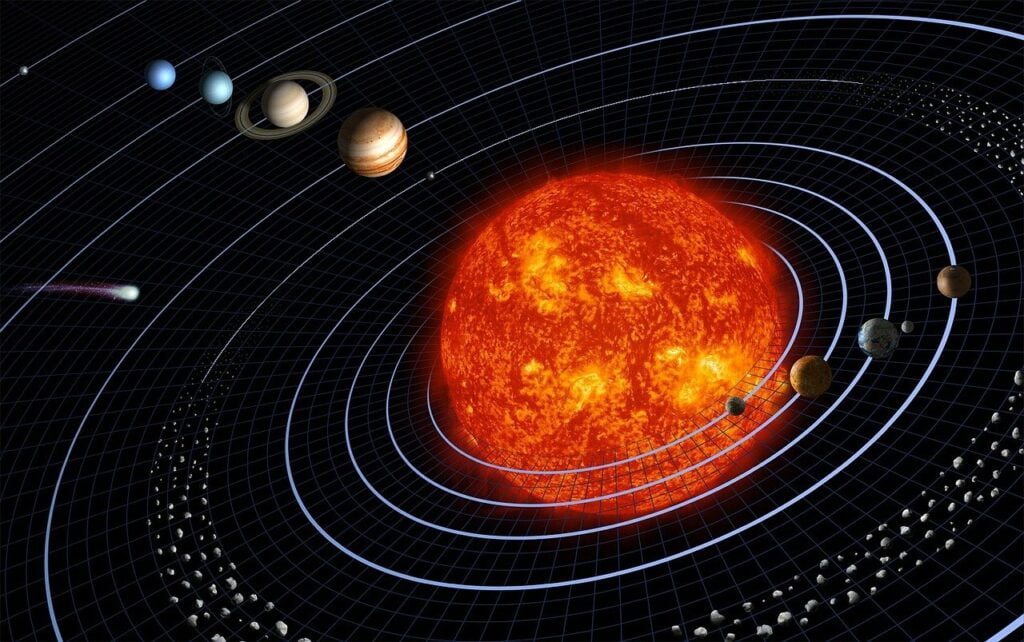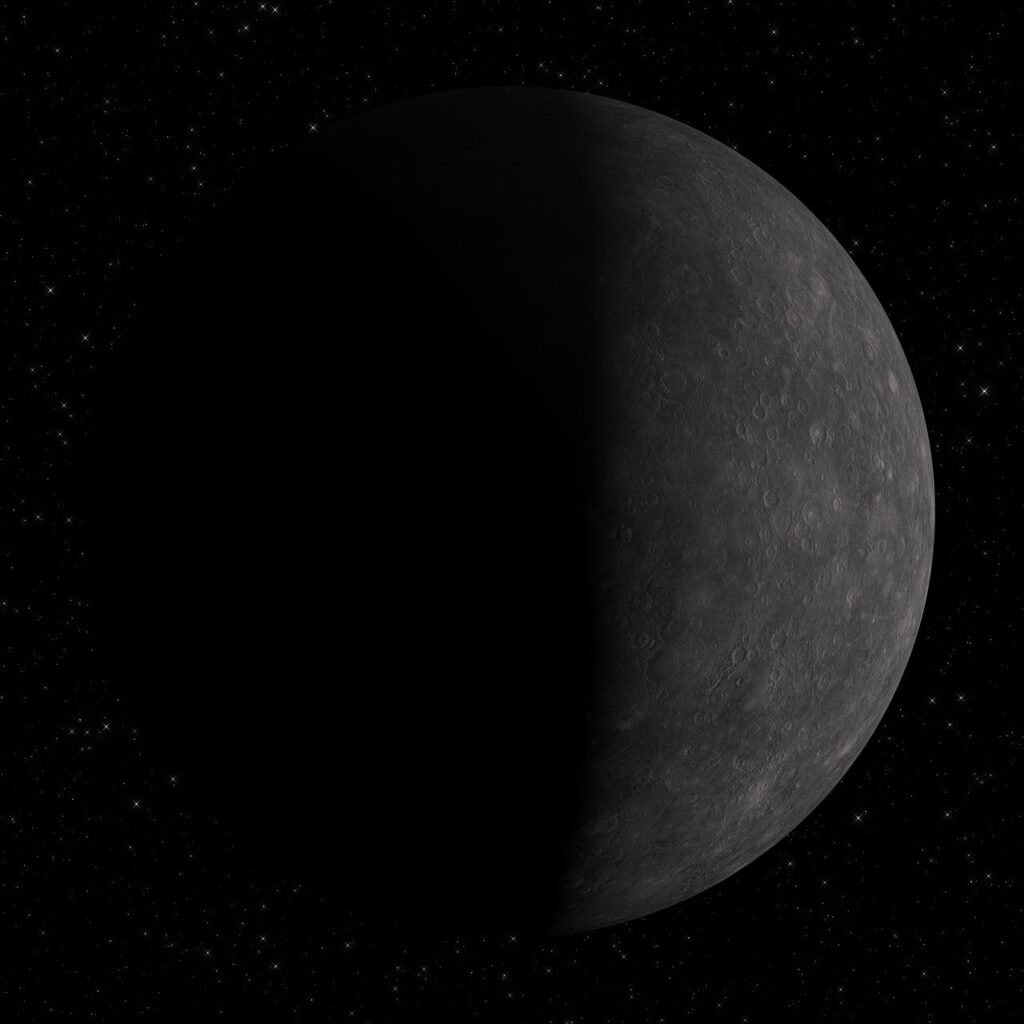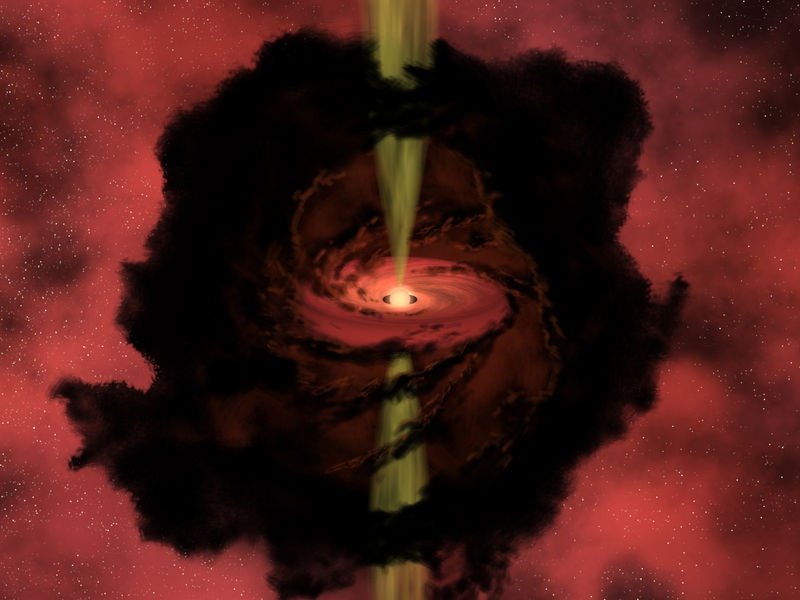
Imagine a vast ocean of gas and dust, spanning hundreds of light-years, swirling in the eternal darkness of space. This is the interstellar medium, the raw material from which stars, like our own Sun, are born. Within this cosmic expanse, dense pockets of gas, known as giant molecular clouds (GMCs), serve as stellar nurseries. Here, amidst the frigid chill and perpetual darkness, the drama of star formation unfolds, beginning with the enigmatic birth of protostars.
But what triggers these clouds to collapse, igniting the embers of new stars? The answer lies in a delicate interplay of cosmic forces. Like dominos toppling in a chain reaction, several factors can nudge a dense region within a GMC to overcome its internal pressure and initiate its journey towards stardom.
Formation of Protostars
Supernova shockwaves
When massive stars reach the end of their lives, they explode in fiery supernovas, sending shockwaves rippling through the surrounding interstellar medium. These powerful waves can compress GMCs, triggering the collapse of dense pockets within them. (Ref: Larson, R. B. 1969, MNRAS, 145, 27)
Stellar winds and outflows
Young, energetic stars expel powerful winds and jets of material. These outflows can interact with nearby GMCs, triggering turbulence and compression, leading to the formation of new stars. (Ref: Churchwell, E., et al. 2002, ApJ, 573, 392)
Galactic shear and tidal forces
The gravitational dance of stars and gas within galaxies can create shear forces that disrupt the equilibrium of GMCs, leading to fragmentation and the birth of new stars. Additionally, the gravitational pull of passing stars or galactic interactions can trigger the collapse of dense regions within GMCs. (Ref: Elmegreen, B. G. 2011, The Formation of Stars, Springer)
As the dense region succumbs to gravity, it begins to contract, gathering more and more material like a snowball rolling downhill. This infall of gas and dust heats up due to the increasing pressure, forming a hot, central core surrounded by a cooler, extended envelope – the protostar is born.
But the story doesn’t end there. The infalling material doesn’t simply plunge straight into the core. Due to the angular momentum inherited from the parent cloud, the gas gets flattened into a rotating disk – the protoplanetary disk. This swirling disk plays a crucial role in the future, becoming the birthplace of planets and solar systems.
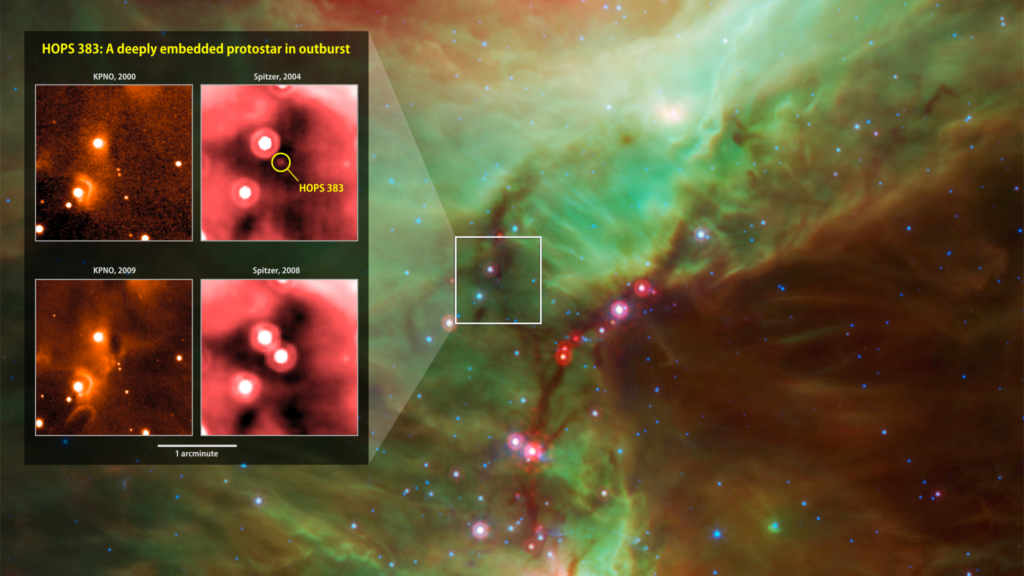
Credit: E. Safron et al.; background: NASA/JPL-Caltech/T. Megeath (Univ. of Toledo)
Structure and Properties of Protostars
Core vs. Envelope: A Tale of Two Regions
Imagine a fiery furnace at the heart of a swirling nebula. That’s essentially the protostar: a hot, dense core where gravitational contraction heats the gas to millions of degrees, simmering on the cusp of stellar ignition. This core, roughly the size of our solar system, is surrounded by a much cooler, extended envelope. This vast reservoir of gas and dust, stretching for light-years, fuels the protostar’s growth as it continuously falls inwards.
The Protoplanetary Disk
But the story doesn’t end with a simple core and envelope. Surrounding the young star like a swirling skirt is the protoplanetary disk. This flattened plane of gas and dust, born from the angular momentum of the collapsing cloud, plays a crucial role in the drama to come. It acts as a birth chamber for planets, providing the raw materials and gravitational interactions necessary for their formation. The disk itself exhibits fascinating internal structure, with hotter, denser regions closer to the protostar and cooler, dustier zones farther out.
Jets and Outflows: A Stellar Tantrum?
Now, prepare for a spectacle! Imagine powerful jets of gas and dust erupting from the protostar’s poles, shooting out into space like cosmic fire hoses. These bipolar outflows are a result of complex interactions within the young star, carrying away excess angular momentum and potentially regulating the rate of infall. These energetic outflows can carve cavities in the surrounding cloud, shaping the future environment of the star and potentially influencing the formation of planetary systems.
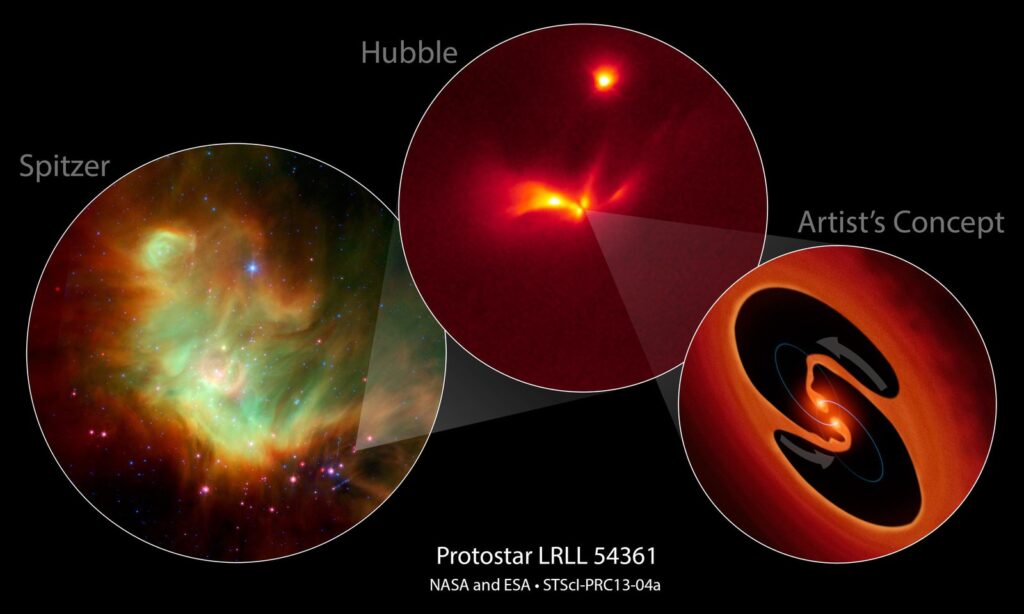
Evolution of Protostars
As the protostar gathers mass and its core temperature rises, a pivotal moment arrives: the flicker of its first flame. But unlike a match igniting in air, the fire within a protostar relies on a different fuel – deuterium, a heavier isotope of hydrogen with an extra neutron.
Deuterium Fusion
Imagine a cosmic game of hot potato with deuterium nuclei. As the core temperature reaches around 1 million degrees Celsius, these nuclei collide with enough force to overcome their mutual repulsion and fuse, releasing energy in the form of gamma rays. This deuterium burning may seem feeble compared to the inferno of true hydrogen fusion, but it marks the first step in a protostar’s journey towards stellarhood.
The Balancing Act: Gravity vs. Pressure
However, the protostar’s existence hangs in a delicate balance. Gravity constantly pulls inward, trying to crush the core further. But as the core heats up from deuterium fusion, the gas pressure within fiercely resists this collapse. This tug-of-war between gravity and pressure defines the protostar’s life. Until a critical point is reached, the outward pressure wins, preventing runaway collapse and allowing the star to continue growing.
Hydrogen Fusion: The Engine Ignites
But the real game-changer awaits. As the core temperature climbs to a staggering 10 million degrees Celsius, a new fusion reaction ignites: the conversion of hydrogen into helium. This process, the very engine that powers stars like our Sun, releases immense energy, outward pressure now exceeding gravity’s grip by a significant margin. The star stabilizes, reaching hydrostatic equilibrium – a delicate balance between inward and outward forces. This marks the momentous transition from a protostar to a full-fledged, main-sequence star.
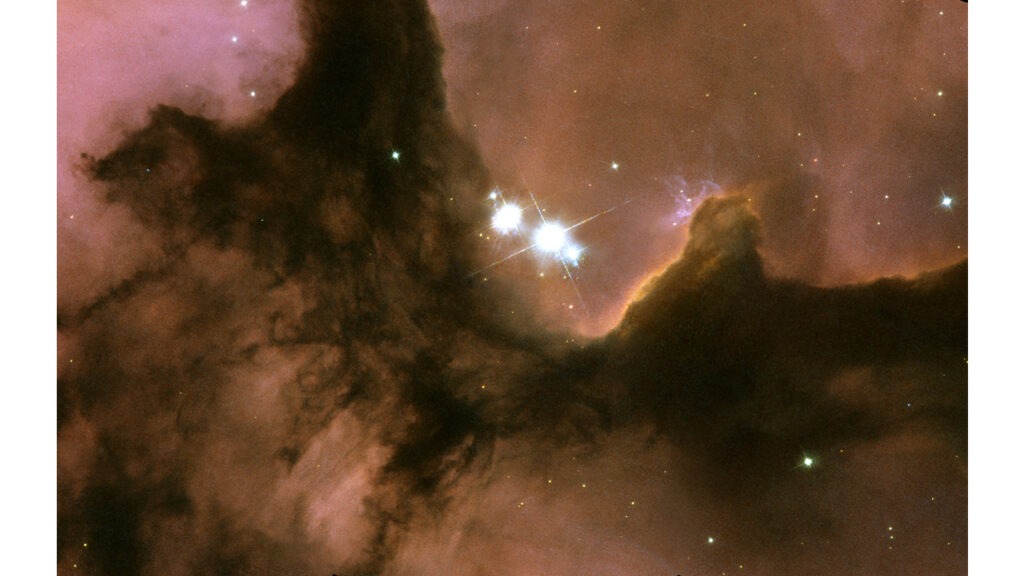
Observational Techniques
While our understanding of protostars has deepened, peering into their shrouded lives presents unique challenges. Imagine trying to study a candle hidden within a thick fog – that’s essentially the task astronomers face when observing these dusty cosmic embryos.
Dust: The Obscurant Curtain
The swirling dust within the clouds where protostars reside acts like a celestial curtain, blocking much of the visible and ultraviolet light emitted by these young stars. This makes traditional optical telescopes largely ineffective in studying them directly. But all is not lost! Astronomers have turned to other wavelengths of light that can penetrate the dusty veil, revealing the hidden secrets within.
Piercing the Dust Barrier
Like night-vision goggles, infrared telescopes allow us to see the heat signature of protostars, revealing their structure and properties even when hidden from optical view. By observing at even longer wavelengths, such as the submillimeter range, astronomers can map the distribution of cold dust and gas surrounding the protostar, offering insights into the infall process and the formation of the protoplanetary disk.
Radio Waves: Decoding the stars
Beyond light, radio waves offer another powerful tool for probing the mysteries of protostars. These energetic emissions, often originating from the star’s bipolar jets and outflows, provide valuable clues about the internal processes at play. By studying the radio waves, astronomers can map the structure and dynamics of these outflows, gaining insights into the star’s rotation, mass accretion, and potential impact on its surroundings.
A Collaborative Effort
Unveiling the secrets of protostars requires a multifaceted approach, combining observations across different wavelengths with theoretical models and simulations. By piecing together the puzzle from various vantage points, astronomers are gradually painting a clearer picture of these stellar infants, their formation, and their ultimate destinies.
Diversity, Mysteries, and Connections
Our exploration of protostars has unveiled a captivating tale of cosmic birth, from the swirling cradle of giant molecular clouds to the fiery ignition of stellar engines. But the story doesn’t end there. The universe harbors a diverse population of protostars, each with its own unique characteristics and evolutionary path.
High, Low, and Binary Tales
Not all protostars are created equal. Low-mass protostars, like our Sun’s humble beginnings, evolve on longer timescales, reaching main-sequence status after hundreds of thousands of years. In contrast, high-mass protostars, burning brightly and fast, reach maturity within a mere few thousand years. These cosmic behemoths often exhibit dramatic phenomena like powerful outflows and intense jets, shaping their environment and potentially influencing star formation in nearby regions. Binary systems, where two protostars dance around a common center of gravity, add another layer of complexity, with their intricate interactions influencing their individual evolutions and potentially leading to unique planetary system architectures.
Future Frontiers
While our understanding of protostars has grown significantly, numerous questions remain. How do different triggering mechanisms influence the properties of the resulting protostars? What role do magnetic fields play in the star formation process? Can we directly observe the elusive moment of hydrogen fusion ignition? Ongoing research, utilizing advanced telescopes and sophisticated theoretical models, delves deeper into these mysteries, pushing the boundaries of our knowledge and painting a more nuanced picture of stellar birth.
From Stellar Seeds to Planetary Systems
The connection between protostars and planetary systems is profound. The dusty disk surrounding a young star serves as the fertile ground where planets are born. The leftover material from the star formation process coalesces into dust grains, which eventually clump together to form planetesimals, the precursors to planets. Studying protostars therefore provides crucial insights into the conditions necessary for planet formation, helping us understand the diversity of planetary systems we observe in the cosmos.
Conclusion
Our exploration of protostars has taken us on a captivating journey, delving into their formation, structure, evolution, and the diverse forms they take. From the challenges of observing these dusty newborns to the mysteries that continue to intrigue astronomers, the study of protostars offers a window into the very beginnings of stars and the potential for planetary systems to blossom. As we continue to unravel their secrets, the universe reveals its awe-inspiring complexity, reminding us that our own existence is intricately woven into the tapestry of stellar birth and evolution.
You may also like
Mercury: The Closest Planet to the Sun
Venus: The Earth’s Twin or a Very Different Planet?
Mars: Comprehensive Exploration, unveiling the Mysteries
Jupiter: A Cosmic Giant – Symphony of Storms
Saturn: A Gaseous Giant with Enthralling Rings and Diverse Moons
Useful Links about Protostars
NASA:
NASA Space Place: Stellar Evolution: https://spaceplace.nasa.gov/search/stars/
NASA Goddard Space Flight Center: Stellar Evolution: https://www.jpl.nasa.gov/news/a-star-is-born
NASA Chandra X-ray Observatory: The Chandra High-Resolution Camera Survey: https://chandra.harvard.edu/ (includes images of young stars and protostars)
ESA (European Space Agency):
ESA Hubble Space Telescope: Birth of Stars: https://hubblesite.org/science
ESA Herschel Space Observatory: Unveiling the Secrets of Star Formation: https://esahubble.org/wordbank/star/
ESA Gaia Mission: Unveiling the Milky Way’s Stellar Secrets: https://www.cosmos.esa.int/web/gaia/data-release-3 (data from this mission can be used to study the locations and properties of young stars and protostars)
JAXA (Japan Aerospace Exploration Agency):
JAXA Subaru Telescope: Star Formation in Our Galaxy: https://subarutelescope.org/en/results/2023/06/06/3272.html
JAXA ALMA Observatory: Unveiling the Secrets of Star and Planet Formation: https://www.almaobservatory.org/en/

